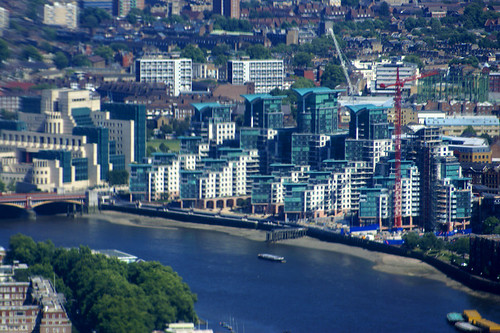Citycape,
The Thames, Vauxhall Bridge, St George Wharf & MI6
Helicopter ride over London
A helicopter sight seeing tour is one of the best ways to see the sights of London. To truly appreciate London, jump in a helicopter and see our Capital city from the air. The helicopters used for these sight seeing tours are renowned as being amongst the world's most comfortable and reliable aircraft and, as you might expect, the views through the cabin windows are excellent. The Thames, Vauxhall Bridge, St George Wharf & MI6, originally uploaded by Craig Grobler.
The ThamesThe Thames is a major river flowing through southern England. While best known because its lower reaches flow through central London, the river flows through several other towns and cities, including Oxford, Reading and Windsor.
The river gives its name to the Thames Valley, a region of England centred around the river between Oxford and West London, the Thames Gateway, the area centred around the tidal Thames, and the Thames Estuary to the east of London.
The River Thames is the second longest river in the United Kingdom and the longest river entirely in England, rising at Thames Head in Gloucestershire, and flowing into the North Sea at the Thames Estuary. It has a special significance in flowing through London, the capital of the United Kingdom, although London only touches a short part of its course. The river is tidal in London with a rise and fall of 7 metres (23 ft) and becomes non-tidal at Teddington Lock. The catchment area covers a large part of South Eastern and Western England and the river is fed by over 20 tributaries. The river contains over 80 islands, and having both seawater and freshwater stretches supports a variety of wildlife.
The river has supported human activity from its source to its mouth for thousands of years providing habitation, water power, food and drink. It has also acted as a major highway both for international trade through the Port of London, and internally along its length and connecting to the British canal system. The river’s strategic position has seen it at the centre of many events and fashions in British history, earning it a description as “Liquid History”. It has been a physical and political boundary over the centuries and generated a range of river crossings. In more recent time the river has become a major leisure area supporting tourism and pleasure outings as well as the sports of rowing, sailing, skiffing, kayaking, and punting. The river has had a special appeal to writers, artists, musicians and film-makers and is well represented in the arts. It is still the subject of various debates about its course, nomenclature and history.
Vauxhall Bridge
Vauxhall Bridge is a steel arched bridge for road and foot traffic, crossing the River Thames in a north-west south-east orientation, between Lambeth Bridge and Grosvenor Bridge, in central London.
On the north bank is Westminster, with Tate Britain and the Millbank Tower to the north-east, and Pimlico and its tube station to the north and east.
On the south bank, Vauxhall Cross, site of Vauxhall station and the headquarters of MI6, lies immediately to the south-east; Kennington is to the east, Vauxhall to the south-east and Nine Elms to the south west. The River Effra, one of the Thames's many underground tributaries, empties into the main river just to the east of the bridge on the south bank.The current bridge was designed by Sir Alexander Binnie, with modifications by Maurice Fitzmaurice, to replace a previous cast-iron structure. It was built by Petwick Brothers.
It was completed in 1906, and opened on the May 26 by the Prince of Wales, and was the first bridge to carry trams across the Thames. It measures 80ft wide by 809ft long, has five steel arches mounted on granite piers, and its most striking feature is a series of bronze female figures on the bridge abutments, both upstream and downstream, commemorating the arts and sciences. The four upstream figures are by F. W. Pomeroy, the four downstream by Alfred Drury.
MI6
Vauxhall Cross is the site of the central headquarters of the British Secret Intelligence Service (more commonly referred to as MI6), which occupies offices built between 1989 and 1992 and commonly referred to as Vauxhall Cross. More recently, a large complex of apartments and offices has been built to the south of Vauxhall Bridge.
The MI6 building has featured in several James Bond films, initially filmed without permission but then condoned by then Foreign Secretary Robin Cook with his memorable "After all James Bond has done for Britain..." quip. It is seen in GoldenEye, The World Is Not Enough (wherein it suffers a fictional terrorist attack that prefigured a genuine incident) and Die Another Day. The latter featured a fictional London Underground station, Vauxhall Cross, a supposedly closed stop on the Piccadilly Line now employed by MI6 as an extension to its HQ. In fact, the Piccadilly Line does not come south of the river at all; only the Victoria Line passes anywhere nearby, and the secret entrance to the station shown in the film is on the east side of Westminster Bridge some considerable distance down river.


















0 comments: